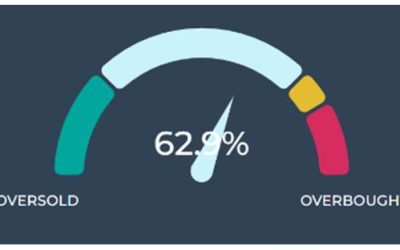by Louis Navellier
October 21, 2025
As of last Friday, the Atlanta Fed’s GDPNow model points to 3.9% GDP growth in the current quarter, while their tally of the top 10 forecasting services sees 2.5% growth. The latest Wall Street Journal survey of economists forecast fourth-quarter GDP growth at a 1.7% annual pace, but that’s up from their July forecast of 1% for this quarter. The federal government shutdown is expected to impair consumer confidence a bit, but since government tends to impede productivity, the shutdown may actually be a plus.
If anything threatens to impede growth this quarter, it could be consumer and business sentiment, since the National Federation of Independent Business said last Tuesday that its optimism index, a gauge of sentiment among small firms, fell by two points in September to 98.8. Economists expected sentiment to hold steady at 100.8, so the drop in sentiment came as a surprise. Approximately 64% of small business owners said that supply-chain disruptions were affecting their business to some degree, but the index’s uncertainty component rose 7 points in August to 100, which was the fourth-highest reading in more than 51 years. If business sentiment falls, this small business caution could impede fourth-quarter GDP growth.
In addition, the Fed’s Beige Book survey, released last week, revealed that only three of 12 Fed districts reported growth. The other nine districts reported flat or contracting economic activity. The Beige Book survey reported that consumer spending decelerated, and businesses remain cautious. Many businesses were reducing their headcount through attrition and layoffs, so the job market remains soft. Overall, the Beige Book survey provided the Fed with plenty of reasons to continue to reduce key interest rates.
Sorkin’s New Book Tour Sows the Seeds of Pessimism
I have noticed that the mainstream media is trying very hard to prick the stock market’s AI bubble. The latest attempt was a 60 Minutes interview with CNBC’s Andrew Ross Sorkin about his new book, entitled “1929: Inside the Greatest Crash in Wall Street History, and How It Shattered a Nation.” During his 60 Minutes interview, Sorkin said, “I think it’s hard to say we’re not in a bubble of some sort. The question is always when is the bubble going to pop?” Sorkin said SEC rules have become less stringent and “the Consumer Protection Bureau practically doesn’t exist.” He concluded by saying, “It’s not that we’re going off a cliff tomorrow. It’s that there’s speculation in the market today, there’s an increasing amount of debt in the market today, and all of that is happening against the backdrop of the guardrails coming off.”
I must adamantly disagree with Andrew Ross Sorkin, since the current stock market environment is nowhere near as manic and leveraged as it was in 1929. The AI boom is very real, and the data center boom is simply incredible. As in any stock market, there is some froth, fueled by option activity as well as leveraged ETFs, but we are not in the 10-to-1 leveraged situation, as too many investors were in 1929.
Frankly, I think the real reason that 60 Minutes conducted such a negative article with Andrew Ross Sorkin is that they are worried that President Trump’s economic agenda is starting to work and it may create more prosperity for more Americans. My advice to both 60 Minutes and Andrew Ross Sorkin is to quit being such a sourpuss in the midst of an economic boom that could hit 5% GDP growth in 2026!
Earnings Announcements and a Fed Rate Cut Should Push the Market Higher
Third-quarter announcement season is off to a great start, with major financial institutions reporting better-than-expected results. Although flagship financial stock JPMorgan Chase reported a 12% increase in third-quarter earnings, it also posted credit losses of $3.4 billion during the quarter – the highest in over five years! The Tricolor (subprime auto loans) bankruptcy liquidation caused Morgan to write down $170 million in the third quarter. During an analyst call, CEO Jamie Dimon said of Tricolor, “When you see one cockroach, there are probably more,” so it is no surprise that Morgan allocated another $810 million in reserves for bad loans. Also, Zions Bankcorp announced on Thursday that it would take a $60 million provision for credit losses, which is its highest loan loss provision since 2022.
Jamie Dimon also said the U.S. economy remained resilient despite some “signs of softening, particularly in job growth.” Dimon also said that the economic impact of tariffs “has been less than people expected, including us,” adding that the final outcome of the new tariff negotiations has yet to be seen.
Fed Governor Christopher Waller was on Bloomberg last Thursday, making a convincing case for the Fed to cut key interest rates at its late-October FOMC meeting, due to ongoing labor market concerns. Since Fed Chairman Jerome Powell is effectively a lame duck, Waller has emerged as a new co-leader on the FOMC and is one of five candidates that the Trump Administration has named as a candidate to become the next Fed Chairman. Waller’s foresight into the labor market weakness before the Labor Department downward revisions makes him stand out as an economic expert. I should also add that Waller is not worried about inflation returning, due in part to weak global economic growth and low crude oil prices.
Last Tuesday, in a speech at the National Association for Business Economics, Fed Chairman Jerome Powell acknowledged recent weakness in labor markets, which effectively signaled an impending key interest rate cut. During a question-and-answer segment, Powell said, “You’re at a place where further declines in job openings might very well show up in unemployment,” adding, “You’ve had this amazing time where you came straight down, but I just think you’re going to reach a point where unemployment starts to go up.” The Fed Chairman also commented about the lack of economic data and called government economic data the “gold standard,” while admitting that the Fed is also looking at private economic data. The good news is that a key interest rate cut on October 29 is now 100% certain.
September retail sales were supposed to be announced on Thursday, but due to the federal government shutdown, this report was postponed. As a result, same-store sales have emerged as a more important indicator to gauge retail sales. Expectations for the holiday shopping season remain low due to the federal government shutdown and a weak labor market, but the holidays tend to boost consumer spending.
Turning to Europe, Euro-stat announced on Thursday that the European Union’s (EU) exports to the U.S. declined 26% in August to $38.3 billion. In the past 12 months, EU exports to the U.S. have declined 22%. On Wednesday, Euro-stat announced that EU industrial production declined 1.2% in August, led by a massive 5.2% drop in industrial production in Germany. Industrial output also declined in France and Italy.
China continues to struggle with deflation. Their National Bureau of Statistics announced that consumer prices declined 0.3% in September after falling 0.4% in August. Food prices declined 4.4% in the past 12 months, while energy prices declined 2.7%. In the past 12 months, their producer price index (PMI) has declined 2.3%, so deflation on the wholesale level has continued since May 2022. Deflation in China is due to overproduction of some products as well as an intensifying demographic decline from its “one baby” rule enacted decades ago.
The bottom line is that the economic weakness in China and the likelihood the entire euro-zone could soon slip into a recession make the U.S. an oasis. Germany is already in its third year of a recession, due to soaring energy prices that caused many factories to migrate to Hungary, Poland, the Czech Republic and Slovakia.
German Chancellor Friedrich Merz is now lobbying the European Union (EU) to restrict its net zero emission mandate and to allow more hybrid vehicles to be built. The heads of BMW and Mercedes have been very outspoken than the EU needs to relax its stringent emission goals. I must add here that I actually own two hybrid vehicles, but as car companies make more hybrids, they tend to be too heavy, which is not an ideal solution for the environment. For example, a BMW M5 sedan weighs 5,390-pounds. By comparison, a Cadillac CT5-V Blackwing, an M5 competitor, weighs 4,300 pounds and, being lighter, is a more nimble, better handling car.
Ed Yardeni’s Wednesday briefing was entitled, “Gold is The New Bitcoin.” Specifically, Yardeni said, “Risk-off investors may be concluding that gold offers greater protection from geopolitical risks than bitcoin, which is more like a risk-on speculative vehicle and has been weak recently.” Furthermore, he said, “We now think the gold price could reach $5,000 an ounce by year-end 2026 and possibly $10,000 by the decade’s end, if not before.” I am now recommending 11 gold stocks in my various portfolios. What I especially like about these gold stocks, other than their strong forecasted sales and earnings, is that they are “co-variance” stocks – they typically “zig” when the stock market “zags.” I may find even more gold stocks to recommend soon.
Navellier & Associates; own JPMorgan Chase & Co. (JPM), in some managed accounts. Navellier does not own Tricon Capital (TCN), or Zion Bank (ZION. Louis Navellier does not personally own JPMorgan Chase & Co. (JPM), Tricon Capital (TCN), or Zion Bank (ZION)..Income Mail
The post 10-21-25: Rising Earnings and the World’s Best Economy Point to a Rising Market appeared first on Navellier.





